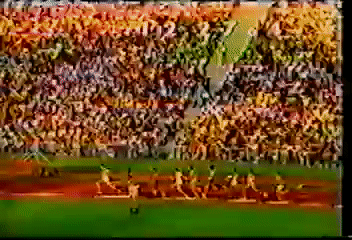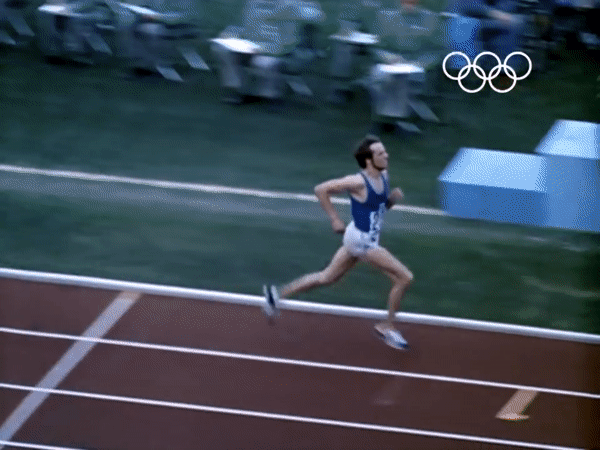While trying to assess the 2020 MLB season, I think of this comparison: if the regular 162-game season is a marathon, then a good Olympic event comparison to the shortened 2020 season would be the 10,000-meter race.
I mean, the ratio is not exactly the same (10,000 meters is not 37% of the 42.2 kilometers of a marathon as the 60- game schedule was to a “normal” season) but, in my mind, it feels similar: this season was both long and short in the way that players could not afford to lose intensity because any slip would have a drastic impact on overall performance, just as in the Olympic 10 kilometers.
What does this mean in baseball terms? Well, simply put, in such a short season, if you fall into any kind of bad stretch there might be not enough games to try to make up for it; your numbers will suffer as there is not enough time to recover.
Let’s look at Nelson Cruz, Franmil Reyes, and J. D. Martinez’s 2020 season, for example, in terms of their rolling average wOBA:

Data Visualization by @Kollauf on Twitter
As FanGraphs describes, wOBA “is one of the most important and popular catch-all offensive statistics… [It was created to] measure a hitter’s overall offensive value, based on the relative values of each distinct offensive event.” It’s a fair and widely used stat for evaluating a player’s offensive capacity. Last season the average wOBA for the league was .320. A wOBA between .340 and .370 is considered above average, .370 to .400 is great, and anything above .400 is excellent. wOBA below .300 is bad.
Martinez was consistently bad during the whole short-season with an abysmal .290 wOBA. He was particularly poor in two, seven-game stretches (one at the beginning and one at the end of the season) when he batted well under his final wOBA for the season (.290). Those 15 games took around 20% of his overall wOBA, carrying it from bad to disastrous.
The Master of Father Time, Cruz, had another great season, and his .411 wOBA shows it, even when his own pair of seven-game bad stretches put a hit on his final figure. Still, in this case, he had a good enough lead that it allowed him to maintain respectable numbers.
Let’s be clear—there are expected and normal stretches where batters struggle; they happen every year alternating with hot streaks, finally combining for what we are used to seeing in a normal season; it’s just that in 2020 their weight was amplified due to the small sample. That’s part of the added complexity of how to properly analyze what happened last year.
This brings us to Reyes.
During 2020, he had a .341 wOBA, which ranked him an unenthusiastic 66th place among qualified hitters, a 112 wRC+ (72nd overall), and a pedestrian 0.6 fWAR (heavily impacted by being a DH, of course, since fWAR also includes a player’s defense). His slash line was .275/.344/.450, and he had 9 HR, 27 runs, and 34 RBI to go with it. Not bad, but nothing particularly shiny about it.
For comparison, there was this player who played 12 fewer games than Reyes’ 59, batted .304/.381/.500, had a .375 wOBA, and a sweet wRC+ of 135. Also, in just 47 games, he had eight home runs, 24 runs, and 30 RBI.
A tale of two players, 2020 edition:
| Name | G | Avg | OBP | SLG | R | HR | RBI | wOBA | wRC+ |
|---|---|---|---|---|---|---|---|---|---|
| Franmil Reyes | 59 | .275 | .344 | .450 | 27 | 9 | 34 | .341 | 112 |
| Player B | 47 | .304 | .381 | .500 | 24 | 8 | 30 | .375 | 135 |
Most teams would prefer Player B even though he played fewer games. Of course, that player is Franmil Reyes, but instead of including his bad 12-game stretch to begin the season, we only include his final 47 games.
Sampling matters
In his first 12 games, Reyes batted .163/.182/.256; after that, he was on a mini-tear, which helped him raise his numbers to more than acceptable levels. We can look at this graphically on that yearly rolling average wOBA.
It’s easy to see that those first two weeks had a very lasting impact on his yearly numbers. To return, briefly, to Olympic running, Reyes’ start was similar to what happened to Virén Lasse, the last running Flying Finn, in the 1972 10,000 meters event at the Munich Olympic Games. Virén had a disastrous fall during the first part of the race:

After his fall, he lost a lot of ground and had to make a tremendous effort to get back into a good position.
Reyes’ start was not unique. Chad Young wrote a superb article on batters that we should consider because they struggled to start the season and then got their production back on track. Here, I am going to take a deeper look at Reyes’ case and what we can (and can’t) make of it.
We’ve already established that two weeks greatly negatively impacted Reyes’ overall results last season; now, the real question is, does it mean that he will be better in 2021?
The easy (and lazy) route to try to find out would be to extrapolate 2020 results to 2021. However, a more appropriate way is to rely on any (or all) of the well known and trusted projection systems in the fantasy baseball community.
| Proj | Age | PO | PA | R | H | 2B | 3B | HR | RBI | BB | SO | SB | BA | OBP | SLG | OPS |
|---|---|---|---|---|---|---|---|---|---|---|---|---|---|---|---|---|
| ZiPS | 25 | DH | 574 | 74 | 132 | 23 | 0 | 32 | 95 | 52 | 177 | 0 | .257 | .324 | .488 | .812 |
| Steamer | 25 | DH | 631 | 87 | 145 | 25 | 1 | 37 | 98 | 63 | 168 | 1 | .261 | .338 | .508 | .846 |
| The BAT X | 25 | DH | 652 | 83 | 149 | 29 | 1 | 34 | 99 | 64 | 174 | 0 | .257 | .332 | .487 | .819 |
| ATC | 25 | DH | 600 | 78 | 140 | 24 | 1 | 35 | 91 | 57 | 167 | 0 | .262 | .332 | .507 | .839 |
The biggest hurdle Reyes faces for 2021, from a fantasy perspective, is that his DH-designation limits his roster flexibility. That’s impacting his ADP, which, in NFBC drafts, is currently 147, the fifth DH-only pick after Yordan Alvarez (84), Nelson Cruz (94), J.D. Martinez (96), and Giancarlo Stanton (116). I’d like to focus on this group by comparing their Dynamic Hard Hit percentage (DHH%), the standard deviation of their launch angle (Sd(LA)), and their relationship, Q, for the 2018, 2019, and 2020 seasons.
For more information on DHH%, Sd(LA), and Q, you can take a look at this piece I wrote when introducing the “Q.” Basically, DHH% describes how often a batter hits the ball hard but in a way that the threshold is not a fixed exit velocity value (as it is >95 MPH for HH%, for example) but it changes depending on the launch angle; Sd(LA) describes the tightness or the distribution of the launch angle (as in whether the batter repeats his movement in a way that his LA stays consistent), and Q is the result of dividing DHH% by Sd(LA), so a higher DHH% and a lower Sd(LA) are desirable and represented by it.
Here are those numbers for 2018-2020 and a calculation for those factors for a combined 2019 and 2020 seasons:
| Name | DHH% (2018) | DHH% (2019) | DHH% (2020) | DHH% (2019-2020) | Sd(LA) (2018) | Sd(LA) (2019) | Sd(LA) (2020) | Sd(LA) (2019-2020) | Q (2018) | Q (2019) | Q (2020) | Q (2019-2020) |
|---|---|---|---|---|---|---|---|---|---|---|---|---|
| Giancarlo Stanton | 37.00 | 37.10 | 40.80 | 39.30 | 30.69 | 32.82 | 27.83 | 29.90 | 1.206422 | 1.131545 | 1.466537 | 1.314046 |
| Nelson Cruz | 34.80 | 32.50 | 27.20 | 31.00 | 29.74 | 28.81 | 27.79 | 28.50 | 1.168269 | 1.128651 | 0.978917 | 1.088513 |
| Yordan Alvarez | 26.40 | 57.10 | 27.30 | 25.41 | 30.72 | 25.50 | 1.037451 | 1.859935 | 1.069458 | |||
| Franmil Reyes | 22.80 | 27.80 | 27.30 | 27.70 | 29.45 | 30.32 | 25.62 | 29.00 | 0.773437 | 0.917699 | 1.064322 | 0.953242 |
| J.D. Martinez | 25.20 | 16.60 | 8.50 | 14.50 | 24.45 | 24.00 | 25.88 | 24.50 | 1.029536 | 0.689594 | 0.328292 | 0.590498 |
Reyes does not have the highest DHH% (that belongs to Stanton) or the tightest Sd(LA) (that is Martinez) of the group, but he still hits the ball very hard and has reduced his Sd(LA) enough that his Q ranked 14th for the 2019-2020 period among all batters with 110 or more BBE during that span. As a result, his numbers should be better than Martinez’s while going more than 50 picks later and having a similar profile to Stanton and Alvarez without the injuries concern, making him a safer bet than them.
Also, unlike Alvarez and Stanton, his Sd(LA) has been improving season after season, which will also help his batting average profile to improve.
Cruz is probably the batter that could provide a better ROI than Reyes, but there is always the chance that age finally catches up with him, although sometimes it looks like he’ll play until he is 50 years old. Also, as with Martinez, Reyes is available around 50 picks later than Cruz.
For those watching closely, I was a little light on the BBE cutoff for the 2019-2020 period due to the short playing time from Stanton and Alvarez (because they missed time due to injury); if we increase it to a more reasonable 300 BBE, Reyes gets to the 12th position in Q and reaches the 18th position in Blast% with 8.5%.
Blasts are a subset of Barrels, the category devised by the smart guys at Baseball Savant, which groups those BBE with really high batting average and slugging. As Alex Chamberlain puts it in this great piece about Blasts: “Since the start of 2017, barrels averaged a 1.416 wOBAcon, 58% home run rate, and .804 AVG. Now, blasts average a 1.744 wOBAcon, 82% HR/BBE, and .919 AVG.” It turns out that we can get a lot of info, even predictive, on guys that have a higher Blast%, and Reyes was in the top 20 during the 2019-2020 timeframe (300 BBE minimum).
Reyes’ BABIP for 2020 is a red flag, for sure. A BABIP of .355 is not sustainable; as he owns a .314 career number in that department, this means his batting average could suffer. On the other hand, his BB% has been rising from 8.4% in 2018 to 10.0% in 2020, and most projections target him for 9.5% next season while his K% has stayed constant around 28.6%, meaning that he’ll take more walks and that will help balance his batting average.
He also showed some improvements in a few discipline stats: his O-Swing% went down from 34.3% in 2019 to 31.1% in 2020, meaning he is chasing fewer pitches, his Swing% and FStrike% went from 51.5% and 62.6% to 46.0% and 58.5% in the same period, pointing to a more patient approach at the plate. For comparison, Cruz and Martinez saw those stats increase. In that regard, I believe a .270 or a little higher batting average in 2021 is quite possible for Reyes.
There is another reason I’d rather take Reyes than Cruz or Martinez, and it’s related to their maximum exit velocity (MaxEV):
| Name | 2018 | 2019 | 2020 |
|---|---|---|---|
| Franmil Reyes | 115.4 | 115 | 114.7 |
| Nelson Cruz | 117 | 117 | 114.4 |
| J.D. Martinez | 116.7 | 112.6 | 110.7 |
As we can see in the table, Martinez’s MaxEv has been trending the wrong way since 2018, another reason to stay away from him. Cruz and Reyes had pretty much the same MaxEV (still with an edge for Reyes, 114.7 to 114.4), but Cruz is also on the decline with it—less sharp than Martinez’s but still a decline.
While you could argue that Reyes’ MaxEV has dropped since his debut in 2018, let’s remember that we did not have a full season, and he reached his MaxEV of 114.7 MPH in only 147 BBE; some recent research on the matter (again by Chamberlain), proposed that 90% of the hitters reach 98% of their MaxEV for a complete season at around their 150 BBE. One way to read this in our case is that Reyes could’ve had a MaxEV a little on the north side of 117 mph. Cruz’s would’ve been a little less than that.
This could mean that Reyes is, in fact, increasing his MaxEV while Cruz is steady, giving the Reyes another small advantage there.
Bottom line, I find Franmil Reyes‘ ADP too good at this moment to let it pass, and even though he completely lacks any speed on the bases, the ROI should be better than a lot of other players picked before him.
By the way, Virén ended up winning the race, setting a new world record while obtaining the gold medal in the process.

Reyes finished with good numbers despite the terrible start in 2020, not as remarkable as world record numbers, of course, but we can hope that this carries into a breakout season in 2021.
Photos by Frank Jansky/Icon Sportswire and Erik Drost/Wikimedia Commons | Adapted by Jacob Roy (@jmrgraphics3 on IG)

